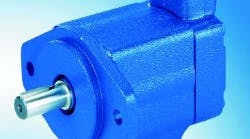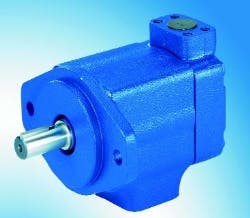For years, the terms hydraulics and environmental were pretty much mutually exclusive. However, today's manufacturers have strived to make hydraulics cleaner, more efficient, and in tune with environmental sensibilities. We heard from arguably the four largest manufacturers in the field about developments at their companies: Parker Hannifin, Cleveland; Eaton Hydraulics, Eden Prairie, Minn; Bosch Rexroth, Hoffman Estates, Ill., and Sauer-Danfoss, Ames, Iowa. Joe Kovach, Ph.D, vice president of technology & innovation for Parker Hannifin, notes that it is important to first look at why people don't like to use hydraulics. He says they are perceived to be:
• leaky
• noisy,
• inefficient,
• difficult to control, and
• big, bulky, and heavy.
Solving most of these problems goes hand in hand with making hydraulics a more environmentally friendly technology. Kovach maintains that, "Every one of our products is being examined from these aspects," so as to make the next generation of components more compatible with environmentally friendly systems.
The mobile world
Mobile machinery is one portion of fluid power where environmental concerns are of critical importance. Many government entities, including the European Union, are placing stricter rules on waste products (like hydraulic fluids) generated by heavy machinery. Thelma Marougy, principal engineer and lubricant specialist for Eaton Hydraulics, notes that, " Environmentally friendly hydraulic fluids have increasingly been specified for use on hydraulic machinery working in environmentally sensitive areas — particularly for mobile equipment used in forestry, construction near water streams, mining operations, and the entertainment industry."
Sauer-Danfoss has gathered and documented data on its testing experience with biodegradable fluids, and shares this with customers upon request. It also views the ongoing performance improvements in its hydraulic systems and components to be helpful to the environment, as more efficient systems minimize heat loss, prevent leakage, reduce noise levels, and conserve fuel. "Our support for Environmentally Aware (EA) hydraulic systems has increased since the late 80s, when we began working in an industry consortium with Hamburg University," said Randy Rodgers, product portfolio manager.
Sauer-Danfoss' new H1 hydrostatic pumps, introduced in March, were designed with the environment in mind. "Our plan is to conduct EA fluid testing with H1 on one or more fluids and to analyze fire resistant fluids, as well," said Rodgers. "One is Union Carbide HP 5046 water glycol fluid, which is both a fire resistant and biodegradable fluid. Our goal is to document the testing and results to share with the OEMs and educate our customers on any issues that arise."
Rodgers says Sauer-Danfoss works closely with any OEM willing to field test a particular fluid, hand in hand with the fluid supplier. Typically, the OEM monitors the fluid sampling regularly with support from the fluid supplier, and after one year, Sauer-Danfoss takes the units back and conducts inspections and performance tests.
Can we have some quiet?
Many users are increasingly concerned with high noise levels. Applications as diverse as packaging lines, automotive assembly, machine tools, and papermaking are looking at ways to reduce noise. One obvious way to do that is to reduce the noise of the components used in the equipment.
Bosch Rexroth has reduced the noise created from its axial-piston and vane pumps through careful analysis and redesign. Pumps create noise through small variations in the fluid moving through the pump. These variations show up as pressure ripple derived from three sources:
• flow and pressure ripples give rise to fluidborne noise,
• pressure ripple causes the pump housing to flex and cause airborne noise, and
• ripple in the drive torque is communicated to the structure as structure-borne noise.
Making a quieter pump involves reducing the pressure ripple during transitions from suction to pressure, reducing the flexing of the housing, and damping or breaking the communication paths transmitting noise. Computer analysis modeled the flow of fluid and any flexing of the housing, allowing a redesign of the structure to smooth the flow and reduce flexing.
Engineers also studied the effects of mounting. Isolation mounts separate the pump from the structure it is attached to, cutting transmitted noise and helping damp noise generated. Pulsation dampers can also control any fluid-borne noise that is generated.
The lesson is that noise reduction occurs on two levels: design and application. Bosch created a significantly quieter pump, then studied the most noise-efficient way to mount it.
Eaton recently installed a new noise room, in acknowledgement of the importance of noise reduction. Their M-Series open-circuit piston pump has a 3-piece housing design, which reduces noise by 60% compared to standard cradle swashplate design pumps. According to Eaton engineers, component noise levels are important, but how they are used in a system also significantly affects the overall system noise. Continued reduction of noise, for the components and for the total system design, are important considerations in Eaton's on-going product designs.
Another way of reducing noise is by designing the hydraulic system to run at low engine speed, thereby reducing engine noise and hydraulic system noise. Read about one such solution from Denison Hydraulics, Marysville, Ohio, beginning on page 22 of this issue.
Efficiency hits the highway
Parker is currently working with advanced energy recovery systems in vehicles, but don't expect to see such a thing in your family vehicle just yet. Today's car engines are constantly ramping up and down as they switch gears, running over a wide range of perhaps 500 to 5000 rpm. Kovach claims that running the engine at the "sweet spot" with constantly variable transmissions (CVTs) can improve efficiency and reduce emissions.
"Honda's got some vehicles on the road now with mechanical bands," says Kovach. "The only problem is that those mechanical bands can't take a lot of power. They're good for light vehicles, but America moves by truck.
"Right now, we have systems running in over-the-highway trucks where we have replaced the mechanical transmissions with hydrostatic transmissions, and we're increasing efficiency and reducing emissions. They can actually provide better overall system performance than many of today's automatic transmissions."
The efficiency of a hydrostatic drive is calculated by multiplying the efficiency of the pump by the efficiency of the motor. Kovach explains, "when typical hydraulic motors ran at 70-80% efficiency, total system efficiencies were just over 50%. Today, some components are running at 95-98%, giving more workable total system efficiencies of perhaps 90-95%.
"States such as Connecticut have now enforced anti-idling laws for a lot of their buses ... at school bus stops, it's been proven that children in some areas are getting asthma from diesel particulates," says Kovach, stressing what manufacturers and system designers are up against, and how critical the environmental issue is.
Kovach says that in current tests, he sees 50% increases in efficiency and 40% reductions in emissions using hydrostatic drive systems in heavier vehicles, such as trucks, buses, and delivery vehicles.
Another way to increase vehicle efficiency is to capture some of the energy normally wasted in the braking process. In the last few years, Eaton has championed a hydropneumatic system called Hydraulic Launch Assist. Brad Bohlmann, Eaton Hydraulics' business development manager for advanced technology, says, "The HLA system lowers fuel consumption and CO2 emissions by 25-35% and other regulated exhaust gases by up to 90% in vehicle applications that make frequest starts and stops in their normal daily routine." The HLA system uses an accumulator to store the energy normally wasted during braking. That energy is released as needed for acceleration, saving fuel cost, extending brake life and reducing wear on the engine and braking system.


